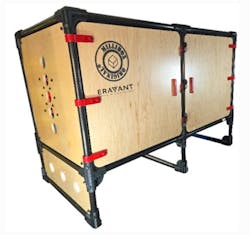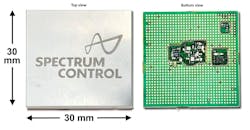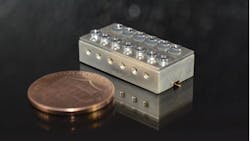What You Missed at IMS 2024 (Part 4)
Browse our complete IMS 2024 coverage.
Here, we offer roundups of coverage from the 2024 edition of the International Microwave Symposium (IMS) in Washington, D.C. This is Part 4 of 4.
MilliBox (Booth 705) unveiled its MBX32CTR, a full compact antenna test range (CATR) that’s capable of producing a 3D radiation pattern in the sub-THz spectrum. CATRs are a type of over-the-air (OTA) antenna test system that use a parabolic reflector to eliminate the far-field measurement distance requirement. When frequency increases, so does the far-field distance, making direct far-field measurements impractical for large antenna-array applications. In such cases, the use of a parabolic reflector and a precisely placed probe make the test system practical as a benchtop setup.
MilliBox’s MBX32CTR provides a complete test apparatus for mmWave and sub-THz OTA measurement with a quiet zone of 150 mm. The system includes an MBX32 chamber, a GIM04H-300E 2-axis positioner, a laser alignment system, and a 300-mm parabolic reflector and its focus probe antenna.
The CATR is the fruit of cooperation between MilliBox and Eravant. MilliBox contributes the chamber and the 3D antenna positioner, while Eravant developed the 300-mm reflector and probes for the required frequency band. Eravant also contributes frequency extenders for spectrum usage above 50 GHz. Maury Microwave provides the StabilityPlus low-profile cable assemblies needed to carry the signals out of the 3D positioner.
TDK Corp. (Booth 2204) has launched a line of ultra-thin, lightweight permalloy film sheets to shield low-frequency-band noise. The IPM01 Series is the latest in TDK’s lineup of Flexield permalloy thin-film sheets; these products feature high permeability and high loss in a 0.006-mm ultra-thin design. The material effectively shields low-frequency noise, which is a growing issue in electric vehicles.
Typically, noise suppression in the kilohertz range is achieved using thick shielding materials, some of which are metallic. They’re often too bulky and heavy for use in EVs, in which minimizing size and weight is a highly sought-after design goal. The IPM01 Series sheets are said to do the job more effectively than those conventional materials while reducing weight. Compared with conventional products in TDK’s lineup, thickness is reduced by about 80%, weight by 90%, and the shielding effect is +65% at 1 MHz.
Products in the IPM01 Series are offered as sheet material and in custom shapes.
Spectrum Control (Booth 208) is to unveil its new RF front-end SiP platform at IMS, the latest addition to its SCi Blocks family. The device comprises a complete wideband RF front-end in a 30-mm2 BGA package. This extensible, customizable, and digitally enabled SiP platform delivers the capabilities of an integrated microwave assembly (IMA) in a surface-mount package. It’s been conceived as a co-processor to Direct RF FPGAs and mixed-signal control processors, but can be used in any application where size, weight, power consumption and cost (SWaP-C) are a factor, such as smart antennas or high-fidelity RF signal conditioning in defense applications.
The first product in the SCRS series is a complete RF front-end with a filtered range of 6 to 18 GHz and unfiltered range of 2 to 20 GHz with 2-GHz instantaneous bandwidth and full signal isolation—and there's no packaging-induced signal degradation. It delivers 15 dB of gain with a noise figure of 6 to 10 dB. Within the device is an on-board FPGA for software-controllable signal conditioning, signal-level detection, self-tuning, on-chip power regulation/sensing, temperature sensing, and a standard digital control interface.
The first SCRS series RF+ SiP is sampling now. Several customization options are available including frequency band, power amplification, and block conversion.
Soitec (Booth 2024) is talking up its extended partnership with UMC, in which Soitec will provide engineered substrates in support of UMC’s industry-first 3D IC solutions for radio-frequency silicon-on-insulator (RF-SoI) technology. UMC’s 3D ICs will take on the challenge of getting more RF front-end modules into a single device by vertically stacking dies and using wafer-to-wafer bonding techniques.
As a result, it’s claimed, overall die size will shrink by more than 45%, enabling designers to integrate more RF components to address 5G’s burgeoning bandwidth appetite. Soitec's RF-SOI substrates provide the requisite mechanical and electrical performance to ensure large-volume manufacturing of UMC’s 3D ICs without degrading RF performance.
At Booth 433, Networks International Corp. is touting its new 9750-MHz surface-mount cavity filter for X-band applications. The device, which is built with high-temperature (Sn95/Sb05) solder, can easily withstand typical PCB reflow profiles of 215°C.
The filter provides a low passband insertion loss of <1 dB and high out-of-band rejection of >60 dB at up to 3X the center frequency. It’s well-suited for applications in radar, electronic warfare, and space-borne systems. Its rugged PCB package offers a profile of <0.3 in. and is available in a hermetic configuration.




